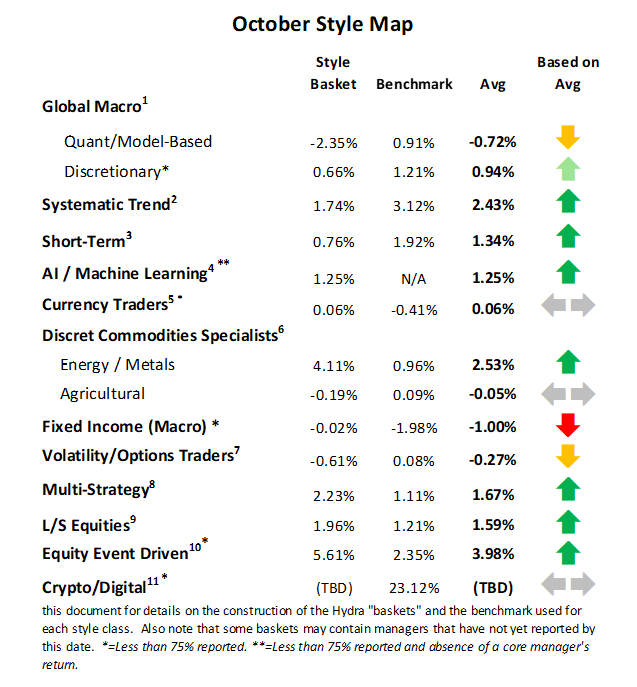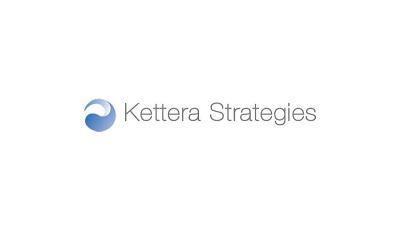Kettera Strategies Heat Map - October 2021
Commodities – Industrial
Metals and energy markets experienced some big rallies (e.g. crude oil +11.3%, Copper +6.5%, ethanol +11.0%, silver +8.1%, etc), which provided some rare opportunities. These appear to be fully taken advantage of by many of our listed managers. The metals specialists on Hydra, in particular, had one of their best months in years. Long positions in precious metals bull spreads appeared to be a big winner along with tactical shorts in base metals. Natural gas peaked early in the month then sold off dramatically, and nimble traders were able to reverse into the sell-off.
Longer Term Trend Followers
October’s theme was that there really wasn’t a theme. Where we used to see different types of systematic trend programs post largely the same performance, that is no longer the case. Many, if not most, of the profitable managers in October thanked the FX markets and commodities as the primary sources of returns, with equities indices also on the positive side. But that’s where the commonality mostly ended. We also noted that those systematic trend managers with greater diversification and longer holding periods (for once) appeared to perform better than the shorter-timed systems. The biggest detractor across the board, however, was fixed income, particularly, it seems, on the shorter end of the curve as global short-term rates spiked abruptly, catching most trend programs wrongfooted.
Quantitative Global Macro
While this style bucket’s close cousin, discretionary macro, edged out a slightly positive month overall, quant macro programs generally suffered in October. Not unlike their more distant cousins above – systematic trend programs – fixed income was the biggest detractor, along with FX. Many quant managers also got blind-sided by the sudden spike in short-term rates and certain long bond positions (e.g Aussie bonds), while short positions in NZD and Aussie dollar hurt the prevailing “strong USD vs. G10” theme. Several quant macro strategies we track were also positioned short in precious metals, which took a toll.
Shorter-Term Strategies
Short-term and higher frequency strategies performed well in October, a welcome relief to what has been a challenging year. The Short-term bucket has more diversity between programs than any other sector (aside from Multi-Strategy). So it’s often difficult to strike a common theme (e.g. one ST specialist may have a discretionary strategy in equities, while another might use a price-driven systematic approach in FX, etc.). But October seemed to bring good fortune nearly across the board in this bucket. The equities sector appeared to yield the most profits for these managers, followed by currencies (for once) and energy markets. Unlike the aforementioned trend and quant strategies, ST programs were able to actually outperform in fixed income and short-term rates. The biggest outperformer in our ST bucket was not an intraday program, but a systematic manager that averages over days and trades a diversity of market sectors.

**********
For the “style classes” and “baskets” presented in this letter: The “style baskets” referenced above were created by Kettera for research purposes to track the category and are classifications drawn by Kettera Strategies in their review of programs on and for the Hydra Platform. The arrows represent the style basket’s overall performance for the month (e.g. the sideways arrow indicates that the basket was largely flat overall, a solid red down arrow indicates the basket (on average) was largely negative compared to most months, etc.). The “style basket” for a class is created from monthly returns (net of fees) of programs that are either: programs currently or formerly on Hydra; or under review with an expectation of being added to Hydra. The weighting of a program in a basket depends upon into which of these three groups the program falls. Style baskets are not investible products or index products being offered to investors. They are meant purely for analysis and comparison purposes. These also were not created to stimulate interest in any underlying or associated program. Nonetheless, as these research tools may be regarded to be “hypothetical” combinations of managers, hypothetical performance results have many inherent limitations, some of which are described below. No representation is being made that any product or account will achieve profits or losses similar to those shown. In fact, there are frequently sharp differences between hypothetical performance results and the actual results subsequently achieved by any particular trading program. One of the limitations of hypothetical results is that they are generally prepared with the benefit of hindsight. In addition, hypothetical trading does not involve financial risk, and no hypothetical trading record can completely account for the impact of financial risk in actual trading. There are numerous other factors related to the markets in general or to the implementation of any specific trading program which cannot be fully accounted for in the preparation of hypothetical performance results and all of which can adversely affect actual trading results.
Benchmark sources:
1-The IndexIQ Hedge Global Macro Beta Index
2-The Societe Generale Trend Index and SG CTA Index
3-The Societe General Short-term Traders Index: (same link as above)
4-The Eurekahedge AI Hedge Fund Index
5-The BarclayHedge Currency Traders Index and BTOP FX Traders Index
6- The BarclayHedge Discretionary Traders Index and Barclay Ag Traders Index and NilssonHedge Commodities CTA Index
7-The CBOE Eurekahedge Relative Value Volatility Hedge Fund Index
8-The Eurekahedge-Mizuho Multi-Strategy Index: (See above)
9-The Eurekahedge Long Short Equities Hedge Fund Index: (See above)
10-Blend of BarclayHedge Equity Market Neutral Index with Eurekahedge Equity Mkt Neutral Index (see link above)
11 – Barclay Crypto Traders Index.
Indices and other financial benchmarks shown are provided for illustrative purposes only, are unmanaged, reflect reinvestment of income and dividends and do not reflect the impact of advisory fees. Index data is reported as of date of publication and may be a month-to-date estimate if all underlying components have not yet reported. The index providers may update their reported performance from time to time. Kettera disclaims any obligation to verify these numbers or to update or revise the performance numbers.
***
The views expressed in this article are those of the author and do not necessarily reflect the views of AlphaWeek or its publisher, The Sortino Group
© The Sortino Group Ltd
All Rights Reserved. No part of this publication may be reproduced, stored in a retrieval system or transmitted in any form or by any means, electronic, mechanical, photocopying, recording or scanning or otherwise, except under the terms of the Copyright, Designs and Patents Act 1988 or under the terms of a licence issued by the Copyright Licensing Agency or other Reprographic Rights Organisation, without the written permission of the publisher. For more information about reprints from AlphaWeek, click here.








